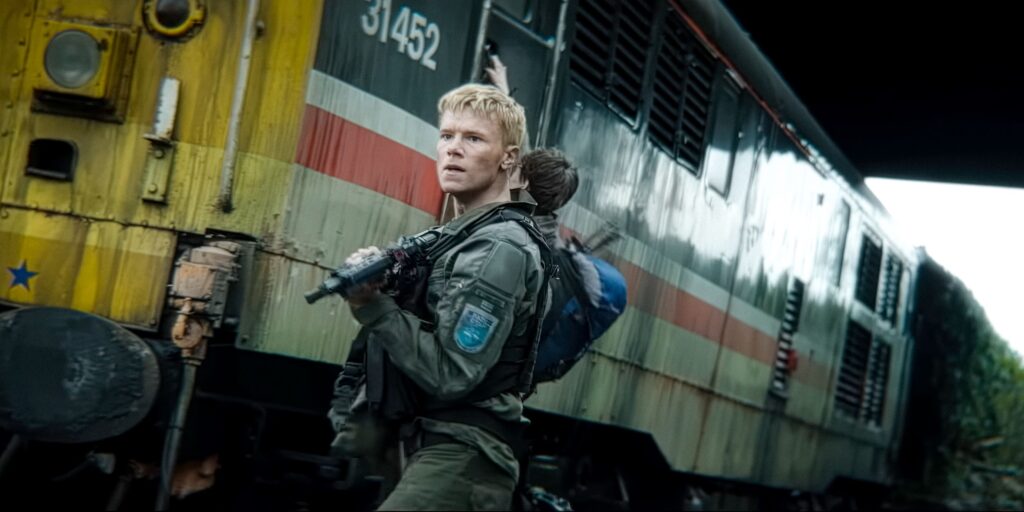Exit 8: The Endless Loop in the Modern Society
A man found himself stuck inside the passage to the subway exit on the way to work.


The main characters in 28 Years Later come from a self-sufficient small tidal island in England, which is isolated from the mainland and the infection. We see things from the view of 12-year-old boy Spike, who lived with his parents inside the community of this island.
For a living condition that is so dependent on each other, this community isn’t an ideal oasis. With the characters being fully Caucasian (one zombie in the mainland wasn’t white-looking), it seems to emphasize the isolation of this town free of urbanization. Spike’s mother, Isla, played by Jodie Comer, has an unknown disease and wasn’t always in a lucid state. Spike’s relationship with his father, played by Aaron Taylor-Johnson, was intimate at first glance as he led Spike’s first adventure to the mainland. While Spike experienced the shallowness of the heroic narrative and witnessed his father’s affair at the party celebrating his triumphant return, the gap between their relationship widened. The only doctor whose service was possibly available to the community was also a social outcast. His valuable skills didn’t guarantee forgiveness for his abnormal behavior or even a chance to explain. Spike left the island to seek the doctor with Isla for a possible cure for her disease, becoming an outsider himself.
Unexpectedly, the disabled mother who was mentally unstable and physically feeble wasn’t a passive side character and didn’t solely remain as a symbol of motivation for the protagonist. She saved Spike during his sleep and an uninfected newborn from the zombie. Her characterization is mainly being a sacrificing mother with the instinct for protecting children, either her own or others’.

A young Swedish man, Erik, joined the navy to prove a point to his friend and was short-lived in this film. His story holds a classic stance of dystopian films on questioning what we choose in our lives. Spike’s confusion about the concept of delivery and online shopping raises a contrast between the life inside the quarantined British Isles and the mundane daily life outside.
The grainy and stylish editing of every kill with the splashing of blood and flesh, the glistening hollow eyes at night, and the olive-colored landscape created the ambient visual experience in 28 Years Later. In a swift motion, the once flourishing town was in a shabby state, covered in green.

The rusty steel sculpture, Angel of the North (1998), by British artist Antony Gormley, also played a role in the film. It means to pay tribute to coal miners and criticize the industrial policies in Britain. Spike’s mother sat under the sculpture and mumbled to her absent spouse in a mental turbulence, with no distinction between the past and the future. Like Walter Benjamin’s “angel of history,” the angel faces towards the past and can’t help being pulled by the future, with the debris piling under its feet. In 28 Years Later, the montage of ancient and modern wars in Britain, as well as the aged rhythmic recording of the poem “Boots” by Rudyard Kipling, was chilling. The psychological torture of the war and its never-ending demand for people’s endurance doesn’t change in a war with zombies—their own dead citizens. In the post-apocalyptic set-up, the community was still established on top of the unchanged history. “Memento Mori,” the skull pyramid and sculptures built by Dr. Kelson, is another direct calling to remember the past in the film and also a visual feast. With Isla’s decease, the processing of how a living body becomes a frightening skull and a part of the history is visceral for the audience.
As a callback from the opening scene, a group of youngsters from Scotland rocking blonde bobs and colorful tracksuits appeared at the end. Their flashy combat with the zombies saved Spike and points to the upcoming sequence, which is disjointed with the rest of the film in tone and narration. Regardless, 28 Years Later is highly enjoyable overall.
The environment in the zombie movies—the fear of infection, the isolation, the run-down business, and the empty urban landscape—isn’t too hard to imagine in the post-Covid period. In the original 28 Days Later, the iconic scene of the empty London Bridge with Big Ben in the background wasn’t too farfetched from the reality. After Brexit, the anxiety about the isolation of Britain is closer to home than in the previous films in the “28 ___ after” series. The new zombie films are bound to present a more daily-life-like post-apocalyptic world, where the domestic problems and history won’t fade away even with zombies approaching.
Related lists created by the same author
A man found himself stuck inside the passage to the subway exit on the way to work.
Related diversity category
Do not trust Rotten Tomatoes. That is what I learned after watching Eternals. Critics currently rate it a 48%, but it's an amazing character-focused Marvel movie with positive diverse representation.
Related movie/TV/List/Topic
Writing great villains is about striking a balance between charming and evil, so we love them but also love to see them lose.